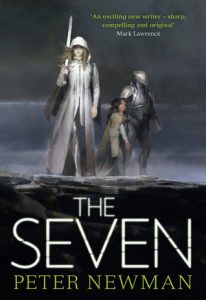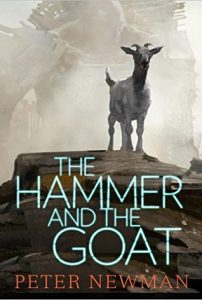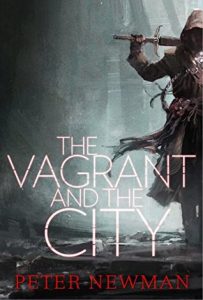The Hammer and the Goat by Peter Newman
 Covers count; every author knows this. Covers can make you buy books, they pose questions, raise mysteries – draw in the eye and the imagination. It is rare, however, for the cover of one book to make you buy a different book, but so it was with me when Fantasy-Faction revealed the cover of The Seven as designed by artist Jaime Jones.
Covers count; every author knows this. Covers can make you buy books, they pose questions, raise mysteries – draw in the eye and the imagination. It is rare, however, for the cover of one book to make you buy a different book, but so it was with me when Fantasy-Faction revealed the cover of The Seven as designed by artist Jaime Jones.
Newman has been fortunate in finding, in Jaime Jones, an artist whose covers consistently capture the essential strangeness (or perhaps the strange essence) of his post-apocalyptic techno-magical demon infested world. In that article Newman shared his own delight in Jones’ work, but also mentioned how the trio depicted in the cover were linked to the events in one of his shorter stories, The Vagrant and the City.
Other authors have augmented their canon of traditionally published work with some hybrid shorter pieces. Daniel Polansky had A Drink Before We Die in the world of Low Town and The Warden. Mark Lawrence has Road Brothers and other pieces giving us a fresh look at Jorg Ancrath and his world. These opportunities to revisit a much-enjoyed milieu enable us to see how else the authors’ imagination could work out in the gymnasium of the worlds they have built.
However, Newman was the first to draw so explicit a link between the set up for the final volume and this excursion into novella (or is it novelette?). Impatient as I was (and am) for the release of The Seven, I felt compelled to prepare myself for the event through a swift read of these swift reads; in this way, the cover of The Seven sold me The Vagrant and the City and – for completeness – The Hammer and the Goat. I consumed each in a single sitting, the two adding up in total to just over a 100 pages.
 The Hammer and the Goat is the shorter of the two and could best be described as 0.5 in the trilogy, since it is set somewhere in the middle of the story described in The Vagrant. Readers may recall a point where The Hammer (Champion of the Usurper) was left for a short while minding the goat (Vanquisher of Vegetation tainted or otherwise). This is the tale of what happened when these two monsters were left together.
The Hammer and the Goat is the shorter of the two and could best be described as 0.5 in the trilogy, since it is set somewhere in the middle of the story described in The Vagrant. Readers may recall a point where The Hammer (Champion of the Usurper) was left for a short while minding the goat (Vanquisher of Vegetation tainted or otherwise). This is the tale of what happened when these two monsters were left together.
True, this could probably have been easily and seamlessly inserted into the main story; but The Hammer deserves her own tale. A tale of how a four-year-old child could become a monster (current parents of four-year-old children may find that not so much a mystery as an everyday occurrence). A tale of the kind of cruelty and stubbornness that only children can know, and the long shadows that childish experiences throw.
The risk of a short story like this is that, unless you do stop halfway through The Vagrant to read it, you will already know the characters’ futures and this may lessen the tension that a story needs to sustain itself. However, there are others besides the Hammer and the Goat to watch and fear for, and The Hammer herself has a struggle to explore with her own nature – all hanging on the toss of a coin. The goat too plays its part, proving there are more ways to solve a problem than with giant muscles; that, sometimes, a giant appetite will serve just as well.
The Vagrant and the City, by contrast, sits exactly between the end of The Malice and the beginning of The Seven, making it book #2.5. It could serve almost as the prologue for book 3 – since it is clear that developments which our heroes experience here carry forward significantly into book 3. However, it is also a complete story in its own right. The powers that be in the Shining City have been set a mystery by one of their colonial outposts and a suitable champion is needed to address the issue. The Vagrant’s impulse to step up to the plate appears more a matter of fleeing from domestic disturbance than running towards heroic service.
 Again, the story is carried by a man who never speaks and whose thoughts we never hear, though Newman does well at describing how he signs and sighs his views and desires to others. There is an intriguing puzzle that drives and completes the story – something more human than demonic. It also provides a powerful window on how the Vagrant’s world has moved on (or perhaps not) since the closing pages of The Malice. Newman’s writing has that terse present-tense quality, but there is also humour in how the Vagrant tries to cope with the passage of time from the halcyon days and simpler challenges of his youth.
Again, the story is carried by a man who never speaks and whose thoughts we never hear, though Newman does well at describing how he signs and sighs his views and desires to others. There is an intriguing puzzle that drives and completes the story – something more human than demonic. It also provides a powerful window on how the Vagrant’s world has moved on (or perhaps not) since the closing pages of The Malice. Newman’s writing has that terse present-tense quality, but there is also humour in how the Vagrant tries to cope with the passage of time from the halcyon days and simpler challenges of his youth.
For someone who has crafted a world filled with body-stealing demons, Newman still does a skilful job of blurring the lines between good and evil, and in so doing offers teasing hints about the way The Seven will carry the story forward to its conclusion.
There are few faiths that can endure a millennium or two since the passing of their founder without experiencing – in some quarters, at least – a drift from their original purpose, a hardening of attitudes, a refuge in hypocritical zealotry. To be immovably certain that you are the good guys is possibly the most corrosive corruption of them all. I suspect that the empire of the winged eye – like the Hammer herself – may face its greatest struggle from within than without. However, my head is spinning as I try to guess in which direction Newman’s elegant and unique tale will next take me.
This review appeared first on Fantasy-Faction on April 12, 2017.
